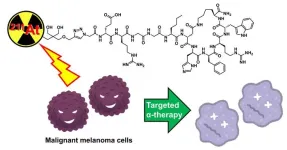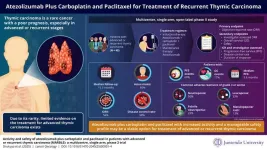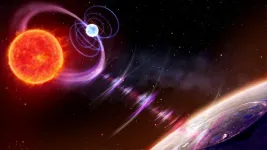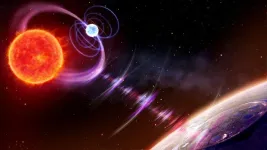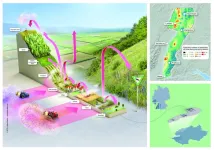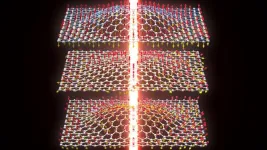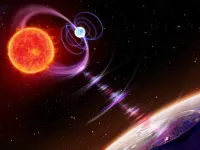(Press-News.org) Metastatic melanoma, also known as stage IV melanoma, is a type of skin cancer that spreads to other parts of the body. It is one of the most aggressive forms of skin cancer, with current therapies—including immunotherapy and targeted drugs—showing limited effectiveness. Radiotherapy is an emerging treatment for melanoma, but conventional beta-emitting radionuclide therapies have limitations due to their low energy transfer and long-range radiation, which can cause unintended damage to healthy tissues.
To enhance the efficacy of radiotherapy, a research team from Japan, led by Assistant Professor Hiroyuki Suzuki from Chiba University, including Dr. Tomoya Uehara from Chiba University, Dr. Noriko S. Ishioka from National Institutes for Quantum Science and Technology, Dr. Hiroshi Tanaka from Juntendo University, Dr. Tadashi Watabe from Osaka University, adopted targeted alpha therapy (TAT) as a promising alternative to conventional beta therapy. They developed an astatine-211 (211At)-labeled peptide drug that could offer a potential breakthrough for treating metastatic melanoma. The research was conducted in collaboration with the National Institutes for Quantum Science and Technology and was published in the European Journal of Nuclear Medicine and Molecular Imaging on January 20, 2025.
TAT is a form of radiotherapy that involves drugs labeled with alpha particle-emitting radioisotopes. Compared to other forms of radioactive emissions (beta and gamma emissions), alpha particles are heavier and therefore have a short range. Owing to their greater mass, alpha particles also carry relatively higher energy, which is beneficial for the disruption of cancer cells.
To develop the treatment, the researchers first identified an optimal hydrophilic linker to enhance tumor targeting and reduce off-target accumulation. The team then designed an astatine-211(211At)-labeled α-melanocyte-stimulating hormone (α-MSH) peptide analog called [211At]NpG-GGN4c to specifically target melanocortin-1 receptors (MC1R), which are overexpressed in melanoma cells. “Since the tagged peptide was also receptor-targeted, it allowed for a high tumor selectivity while minimizing radiation exposure to the surrounding tissues,” comments Dr. Suzuki.
The synthesized peptides were then tested on B16F10 melanoma-bearing mice models, following which they conducted a biodistribution analysis where the team compared tumor uptake, clearance from organs, and the overall stability of the compound. Dr. Uehara elaborates on the methodology, saying, “We treated the mice with different doses of the compound while monitoring the tumor response, body weight, and survival rates over time. We found a dose-dependent inhibitory effect in a melanoma-bearing mouse model, confirming the effectiveness of our approach.”
The findings were remarkable. The [211At]NpG-GGN4c showed high accumulation in tumors and rapid clearance from non-target organs, confirming its specificity for MC1R on melanoma cells. Monitoring tumor growth revealed significant tumor suppression in a dose-dependent manner. Furthermore, [211At]NpG-GGN4c also demonstrated high stability in blood plasma, minimizing the risk of radioactive leakage in the body.
Hailing the exciting results, Dr. Suzuki affirms that the molecular design of their synthesized drug could be useful for developing other 211At-labeled radiopharmaceuticals. He says, “We believe our approach could open up new possibilities for treating refractory cancers beyond melanoma.”
The team is also hopeful about promoting a clinical application of 211At-based TAT. “If successfully translated into human trials, this therapy may emerge as a viable treatment option for patients with advanced melanoma in the coming years,” speculates Dr. Suzuki. “This could provide new therapeutic opportunities for patients with refractory cancer.”
About Assistant Professor Hiroyuki Suzuki from Chiba University
Dr. Hiroyuki Suzuki is an Assistant Professor at the Graduate School of Pharmaceutical Sciences, Chiba University. He earned his doctoral degree from Chiba University in 2013. His research focuses on the development of radiopharmaceuticals. He has made significant contributions to the scientific community through his groundbreaking research focused on radiotheranostics. In November 2024, Dr. Suzuki received the Best Young Investigator Award from the Japanese Society of Nuclear Medicine in recognition of his outstanding contributions to the field.
END
Targeted alpha therapy: a breakthrough in treating refractory skin cancer
A novel radioactive drug developed by researchers demonstrates potential for targeting and treating metastatic melanoma
2025-03-12
ELSE PRESS RELEASES FROM THIS DATE:
Transforming thymic carcinoma treatment with a dual approach
2025-03-12
Thymic epithelial tumors are a rare group of malignancies originating in the thymus gland, that includes thymoma and thymic carcinoma. Among these, thymic carcinoma is the more aggressive subtype, characterized by high invasiveness, metastatic potential, and poor prognosis. With an incidence of just 0.15 cases per 100,000 person-years, its rarity poses significant challenges for treatment development. While platinum-based chemotherapy remains the current standard of care, its efficacy is limited. Immune checkpoint inhibitors have shown promise in pretreated cases, but durable ...
Wrong on skin cares: keratinocytes, not fibroblasts, make collagen for healthy skin
2025-03-12
The skin consists of two primary layers. The epidermis, the outermost layer, is predominantly made up of keratinocytes, while the deeper dermis contains blood vessels, nerves, and structural proteins such as collagen, which give the skin its strength and texture. Traditionally, fibroblasts—specialized supporting cells within the dermis—have been believed to play a key role in producing collagen.
In humans, collagen is formed before and after birth. It has been believed that fibroblasts play an exclusive role in collagen production in the skin, and no keratinocytes contribute to collagen production. The statement “Collagen production in the human skin is achieved by fibroblasts” ...
Delhi air pollution worse than expected as water vapour skews figures
2025-03-12
New Delhi's air pollution is more severe than previously estimated with particles absorbing atmospheric water vapour leading to particulate matter levels across the city being underestimated by up to 20%, a new study reveals.
Hygroscopic growth causes fine particulate matter (PM1) to swell, reducing sampling devices efficiency and leading to underestimation, with greatest underestimation in estimated concentrations happening during winter morning rush hours, when humidity is highest and pollution is most severe.
In contrast, research shows that the monsoon ...
First radio pulses traced to dead-star binary
2025-03-12
An international team of astronomers, including a Northwestern University astrophysicist, has traced a series of mysterious radio pulses to an unprecedented home.
Starting a decade ago, astronomers have detected a pulse of radio emission every two hours, coming from the direction of the Big Dipper. After combining observations from multiple telescopes, the team can now reveal the culprit: a binary system with a dead star.
According to the new study, a red dwarf and white dwarf are orbiting each other so tightly that their magnetic fields interact. Each time they bump together — which is every two hours — the interaction emits a long radio blast.
Although astronomers ...
New membrane discovery makes possible cleaner lithium extraction
2025-03-12
Researchers have developed a new process for sustainable lithium extraction, which could help to address the growing global demand for the metals used in electric vehicle batteries and renewable energy storage.
Current ways of getting lithium are bad for the environment and more sustainable approaches are hard to perform on a large scale, but scientists have developed new membranes to pull lithium directly out of salty lake water using electricity, leaving other metal ions behind.
Publishing their findings in Nature Water today (12 Mar), the international group of researchers from the UK, France, ...
Entwined dwarf stars reveal their location thanks to repeated radio bursts
2025-03-12
An international team of astronomers led by Dr Iris de Ruiter, now at the University of Sydney, has shown that a white dwarf and a red dwarf star orbiting each other every two hours are emitting radio pulses.
Thanks to follow-up observations using optical and x-ray telescopes, the researchers were able to determine the origin of these pulses with certainty. The findings explain the source of such radio emissions found across the Milky Way galaxy for the first time.
The results are published in Nature Astronomy.
In recent years, better analysis techniques have given researchers the ability ...
Landscape scale pesticide pollution detected in the Upper Rhine region, from agricultural lowlands to remote areas
2025-03-12
A recent study by the RPTU University Kaiserslautern-Landau shows extensive pesticide contamination in the landscape of the Upper Rhine Region. The research team led by Carsten Brühl shows for the first time that synthetic chemical pesticides from conventional agriculture do not remain on the cultivated areas, but spread from the lowlands to the Black Forest and the Palatinate Forest. The results show that the entire landscape is contaminated with pesticide mixtures, shedding new light on the potential environmental ...
Decoding nanomaterial phase transitions with tiny drums
2025-03-12
When water freezes into ice or boils into vapour, its properties change dramatically at specific temperatures. These so-called phase transitions are fundamental to understanding materials. But how do such transitions behave in nanomaterials? In Nature Communications, a team of scientists led by TU Delft (The Netherlands) presents new insights into the complex nature of phase transitions in magnetic nanomaterials. Their findings reveal the coupling between magnetic and mechanical properties, paving the way for ultra-sensitive sensors.
The scientists from TU Delft, together with colleagues from the University of Valencia and the National University of Singapore, studied ...
Two-star system explains unusual astrophysical phenomenon
2025-03-12
(Images available via the links in the Notes section) An international team of astrophysicists led by the Netherlands and the UK have discovered that radio pulses lasting seconds to minutes are due to two stars coming together – rather than emissions from a single star. The results are published today (12 March) in Nature Astronomy.
In recent years, a new astronomical phenomenon has puzzled radio astronomers: researchers have detected radio pulses from the Milky Way that last from seconds to minutes. These pulses are unlike anything expected from known radio-emitting neutron stars, or pulsars*, ...
Minimal TV viewing may be protective for heart diseases linked to Type 2 diabetes
2025-03-12
Research Highlights:
A sedentary lifestyle such as watching TV (two or more hours daily) may be a key factor in the risk of developing heart and blood vessel diseases, according to an analysis of health records from a large U.K. biomedical database.
People with higher genetic risk for Type 2 diabetes may be more likely to have a heart attack, stroke or other types of atherosclerotic cardiovascular disease. However, limiting TV watching to no more than one hour a day may help offset the increased risk of these ...
LAST 30 PRESS RELEASES:
Making lighter work of calculating fluid and heat flow
Normalizing blood sugar can halve heart attack risk
Lowering blood sugar cuts heart attack risk in people with prediabetes
Study links genetic variants to risk of blinding eye disease in premature infants
Non-opioid ‘pain sponge’ therapy halts cartilage degeneration and relieves chronic pain
AI can pick up cultural values by mimicking how kids learn
China’s ecological redlines offer fast track to 30 x 30 global conservation goal
Invisible indoor threats: emerging household contaminants and their growing risks to human health
Adding antibody treatment to chemo boosts outcomes for children with rare cancer
Germline pathogenic variants among women without a history of breast cancer
Tanning beds triple melanoma risk, potentially causing broad DNA damage
Unique bond identified as key to viral infection speed
Indoor tanning makes youthful skin much older on a genetic level
Mouse model sheds new light on the causes and potential solutions to human GI problems linked to muscular dystrophy
The Journal of Nuclear Medicine ahead-of-print tip sheet: December 12, 2025
Smarter tools for peering into the microscopic world
Applications open for funding to conduct research in the Kinsey Institute archives
Global measure underestimates the severity of food insecurity
Child survivors of critical illness are missing out on timely follow up care
Risk-based vs annual breast cancer screening / the WISDOM randomized clinical trial
University of Toronto launches Electric Vehicle Innovation Ontario to accelerate advanced EV technologies and build Canada’s innovation advantage
Early relapse predicts poor outcomes in aggressive blood cancer
American College of Lifestyle Medicine applauds two CMS models aligned with lifestyle medicine practice and reimbursement
Clinical trial finds cannabis use not a barrier to quitting nicotine vaping
Supplemental nutrition assistance program policies and food insecurity
Switching immune cells to “night mode” could limit damage after a heart attack, study suggests
URI-based Global RIghts Project report spotlights continued troubling trends in worldwide inhumane treatment
Neutrophils are less aggressive at night, explaining why nighttime heart attacks cause less damage than daytime events
Menopausal hormone therapy may not pose breast cancer risk for women with BRCA mutations
Mobile health tool may improve quality of life for adolescent and young adult breast cancer survivors
[Press-News.org] Targeted alpha therapy: a breakthrough in treating refractory skin cancerA novel radioactive drug developed by researchers demonstrates potential for targeting and treating metastatic melanoma
